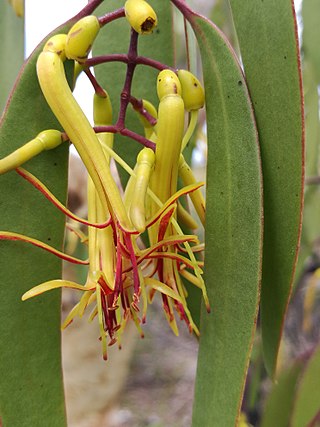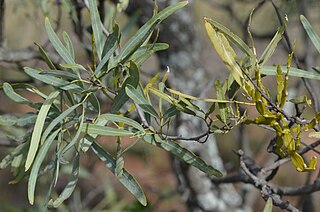
Brachychiton populneus, commonly known as the kurrajong, is a small to medium-sized tree found naturally in Australia in a diversity of habitats from wetter coastal districts to semi-arid interiors of Victoria, New South Wales and Queensland. Carrejun and carrejan were the indigenous names of trees in the foothills of the Blue Mountains near Sydney, and the bark was used for twine and fishing lines. The extended trunk is a water storage device for survival in a warm dry climate. The bell-shaped flowers are variable in colour while the leaves vary considerably in shape. The leaves are either simple and pointed, or may be 3–9 lobed. Saplings grow from a drought and fire resistant tap-rooted tuber.

Angophora hispida grows as a mallee, or as a tree to about 7 m (25 ft) in height. A. hispida's small size, especially when compared to its Angophora and Eucalyptus relatives, leads to it being known by the common name dwarf apple. It is native to a relatively small patch of central New South Wales – from just south of Sydney up to the Gosford area. The plant's leaves are sessile (stalk-less) and hug the stem with heart-shaped bases. Its previous name – A. cordifolia – referred to these cordate leaves. Another distinctive feature are the red bristly hairs that cover the branchlets, flower bases and new growth. This leads to the specific epithet hispida.

Angophora floribunda, commonly known as the rough-barked apple, is a common woodland and forest tree of the family Myrtaceae native to Eastern Australia. Reaching 30 m (100 ft) high, it is a large tree with fibrous bark and cream-white flowers that appear over the Austral summer. It grows on alluvial soils on floodplains and along watercourses. Much of the land it grew on has been cleared for agriculture.

Amyema quandang is a species of hemi-parasitic shrub which is widespread throughout the mainland of Australia, especially arid inland regions, sometimes referred to as the grey mistletoe.

Dendrophthoe vitellina, commonly known as long-flowered- or apostle mistletoe, is a hemiparasitic plant of the mistletoe family Loranthaceae. The genus Dendrophthoe comprises about 31 species spread across tropical Africa, Asia, and Australia. Despite being collected by Joseph Banks and Daniel Solander in 1788, and depicted in Banks' Florilegium, it was not until 1860 that it was described by Ferdinand von Mueller as Loranthus vitellinus after being collected near Ipswich, and renamed by Philippe Édouard Léon Van Tieghem in 1895.

Melaleuca nodosa, commonly known as the prickly-leaved paperbark, is a plant in the myrtle family Myrtaceae, and is endemic to eastern Australia. It is a shrub or small tree with narrow, sometimes needle-like leaves and profuse heads of yellow flowers as early as April or as late as January.

Allocasuarina inophloia, also known as woolly oak, or stringybark she-oak, is a shrub or small tree of the she-oak family Casuarinaceae endemic to inland New South Wales and Queensland. The hairy bark is an unusual feature.

Capparis lasiantha is an endemic Australian plant with a range that extends from the Kimberley region through the Northern Territory and Queensland to northern New South Wales, primarily in drier inland areas although the species extends to the coast in Central Queensland. Common names are numerous and include wyjeelah, nepine, split jack, nipang creeper, nipan, native orange and bush caper.

Muellerina is a genus of parasitic aerial shrubs in the family Loranthaceae.

Muellerina eucalyptoides, commonly known as creeping mistletoe, is a hemiparasitic aerial shrub in the family Loranthaceae. The species is endemic to Australia.

Amyema bifurcata is an epiphytic, flowering, hemiparasitic plant of the family Loranthaceae native to Australia and found in Western Australia, the Northern Territory, Queensland and New South Wales.

Amyema sanguinea is an aerial hemiparasitic shrub within the genus Amyema, in the family Loranthaceae and native to Australia, where it is found in New South Wales, Queensland, the Northern Territory, South Australia and Western Australia.

Amyema melaleucae, also known as the tea-tree mistletoe, is a species of flowering plant within the genus Amyema, an epiphytic hemiparasitic plant of the family Loranthaceae native to Australia and found in Western Australia and South Australia on the coast, from north of Perth almost to the Victorian border.

Muellerina bidwillii, common name Cypress-pine mistletoe, is a hemiparasitic aerial shrub in the family Loranthaceae. The species is endemic to New South Wales and Queensland.

Muellerina myrtifolia, common name myrtle-leaved mistletoe, is a hemiparasitic aerial shrub in the family Loranthaceae. The species is endemic to New South Wales and Queensland.

Muellerina celastroides, common names Banksia mistletoe and coast mistletoe, is a hemiparasitic aerial shrub in the family Loranthaceae. The species is endemic to New South Wales, Victoria and Queensland.

Amylotheca is a genus of hemi-parasitic aerial shrubs in the family Loranthaceae, found in Borneo, Malaysia, New Caledonia, New Guinea, Australia, Sumatra, Thailand, Vanuatu, and Philippines

Korthalsella rubra is a flowering plant in the Santalaceae (sandalwood) family, formerly placed in the Viscaceae.
Amyema plicatula is a species of hemi-parasitic shrub found in the Bismarck Archipelago, New Guinea, New South Wales and Queensland.

Amyema miraculosa, also known as the fleshy mistletoe and the round-leaf mistletoe, is an Australian native mistletoe found in all states except Tasmania. It is a woody, hemiparasitic plant, in the Loranthaceae family. Being hemiparasitic, it draws water and minerals from its host, however it photosynthesises to manufacture its own supply of carbohydrates.


















